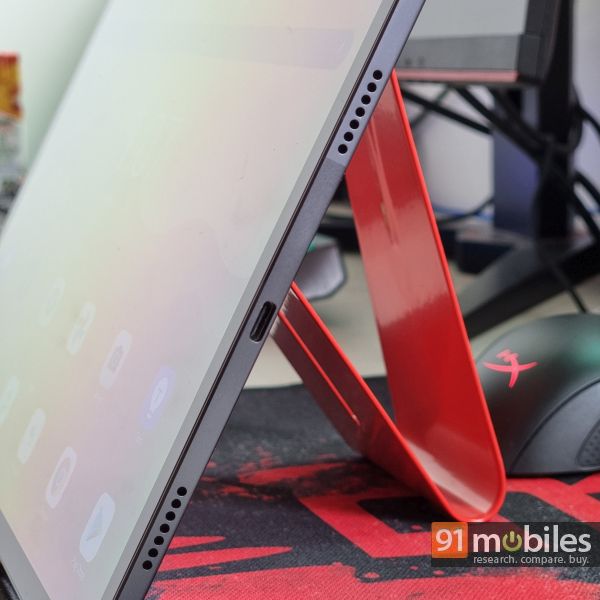I’ve been reviewing consumer tech for the longest time and in all my years of testing a myriad of different products, I’ve seldom been asked for tablet recommendations. That’s not to say that people don’t want to buy tablets anymore but, it does speak volumes about Apple’s monopoly in the segment. You see, most buyers on the lookout for a brand-new tablet usually default to Apple’s products and for good reason – the company’s iPad range offers excellent performance, class-leading features, and more. More importantly, barring Samsung and Lenovo, Android OEMs have all but given up on the category.
Lenovo in fact, recently announced a high-end tablet in the form of the Tab P11 Pro, and in this review, let’s see if it is a viable option for prospective buyers.
Design
Lenovo has taken a page from Apple and Samsung’s notebooks in designing the Tab P11 Pro. In fact, from a distance, the tablet looks eerily similar to Apple’s iPad Air, as well as Samsung’s Tab S7 range. Be it the unit’s rounded-off edges or its flat frame, it’s hard to look past the design similarities on offer here. Be that as it may, it’s hard to refute that the Tab P11 Pro offers a likable chassis. What’s more, the unit feels as premium as any other high-end tablet in the market, thanks in no small part to its unibody aluminum shell – the chassis feels superbly robust and I didn’t notice any squeaking issues with the frame either. Rest assured, the tablet’s industrial design will find plenty of backers.


As for the rest of the I/O, the Lenovo Tab P11 Pro ships with four Atmos-enabled, JBL speakers that have been positioned on either side of the unit’s frame. The orientation is similar to what you might’ve seen on Samsung’s high-end offerings too. The tablet also ships with a USB Type-C port, a volume rocker, and a 4-pin pogo connector that is used to attach the optional keyboard accessory to the P11 Pro. Do note that Lenovo didn’t send me the keyboard accessory and consequently, I won’t be able to comment on the build quality of the same.
Lastly, you should know that the tablet doesn’t ship with a 3.5mm headphone jack so, you will have to invest in a Type-C dongle, or pair the unit with a set of Bluetooth earbuds.
Display and Audio
The Lenovo Tab P11 Pro undoubtedly looks the part of a premium product but what sets it apart from the competition is its display. You see, unlike the similarly-priced Samsung Galaxy Tab S7 FE that sports an LCD screen, the Tab P11 Pro employs an 11.5-inch, 2,560 x 1,600 pixels, 2K OLED display. The panel gets adequately bright at 500 nits too and simply put, is easily the best display in its segment. The icing on the cake is that the device supports WideVine L1 certification and can in fact relay HDR content from services like Netflix too. So, be it watching your favourite serial killer docuseries, or catching up on the latest Marvel show, the Tab P11 Pro will offer a quality, stand-out media consumption experience.

That’s not to say that the panel is perfect and I noticed that the screen’s palm rejection wasn’t the best. Coupled with the tablet’s razor-thin bezels, I found myself unintentionally swiping out of a video or an app more times than I can remember. Moving on, the display’s 60Hz refresh rate leaves a little to be desired too. While the panel feels adequately slick for most tasks, I will admit, the UI animations feel a tad jarring.

Performance and Software
Coming to the meat of the matter, the Lenovo Tab P11 Pro ships with Qualcomm’s Snapdragon 730G processor. The chip works alongside 6GB of LPDDR4x memory and 128GB of built-in, user-expandable uMCP storage. It goes without saying that the Tab P11 Pro is not going to set any benchmarks on fire. However, the unit’s day-to-day performance was to my liking and I rarely ran into any instances of lag or stutter whilst browsing through my social media feeds, opening various video streaming services, or playing some casual games like Clash Royale on the unit.



Verdict
The Lenovo Tab P11 retails for Rs 44,990 and for the price, faces stiff competition from Samsung’s Galaxy Tab S7FE, as well as select iPad models. Now, between the Tab S7FE and the Tab 11 Pro, Lenovo’s offering puts forth a much nicer display along with a better speaker setup. Moreover, unlike Samsung’s offering, the device also ships with a capacitive fingerprint sensor. Consequently, even though the Tab S7FE is backed by a slightly faster chip, I wouldn’t recommend it over Lenovo’s offering.

On the flip side, the 10.2-inch iPad 8th gen can be had for less than the Tab P11 Pro and the device offers more raw horsepower to boot. Furthermore, Apple’s app ecosystem for its iPadOS is better than what Android tablets can offer at the moment. That said, an iPad might not be for you if you prefer the flexibility offered by Android, which brings me back to the Lenovo Tab P11 Pro. On the whole, the Lenovo Tab P11 Pro does enough to warrant a purchase. The tablet is certainly not the best the segment has to offer and is still playing second fiddle to Apple’s iPad range. However, buyers on the lookout for an Android tablet at least have one more option to choose from.
Editor’s rating: 3.5 / 5
Pros:
- Stunning 2K OLED display
- Fantastic speakers
- Premium design
- Long-lasting battery backup
Cons:
- Some app scalability issues in Productivity mode
- Snapdragon 730G chipset might be a bottleneck for power users
- Still boots Android 10





